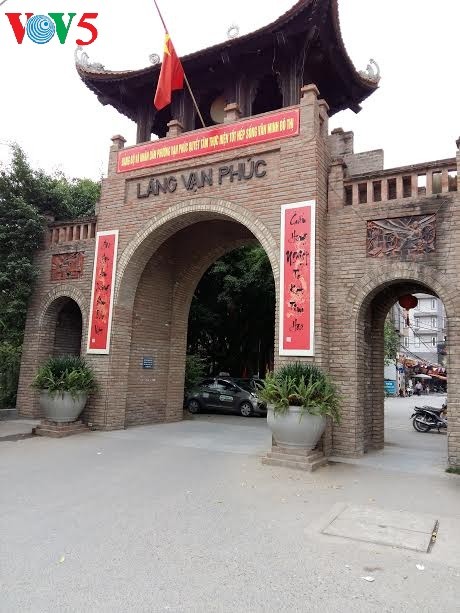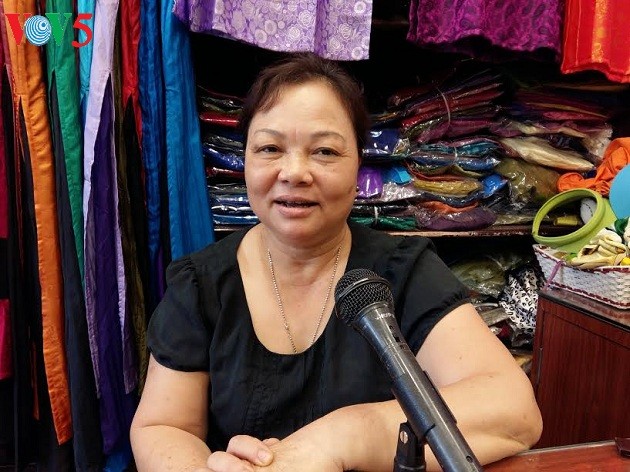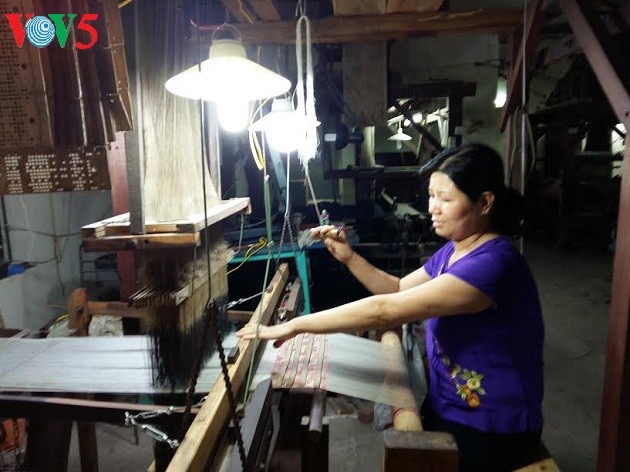(VOVWORLD) - Van Phuc silk village in Hanoi’s outlying Ha Dong district has a time-honored silk weaving craft. Its silk products have inspired poetry, songs, and paintings.

Van Phuc village gate stands out with the parallel sentences which illustrate the confidence and the determination to conserve the traditional profession.
|
According to ancient documents and relics, silk weaving in Van Phuc was begun in the 9th century by A La Thi Nuong, a Hung Vuong descendant. She taught the people of Van Phuc village - which used to be called Van Bao - how to grow mulberries, raise silkworms, and weave silk. After her death, she was honored as the village’s tutelary god. Stonework and an ancient loom have been kept in a local temple, which worships A La Thi Nuong.
Van Phuc silk once was used to make royal clothing and its silk items were favored during the Nguyen Dynasty from 1802 to 1945. Introduced at the Marseille International Trade Fair in 1931, Van Phuc silk became widely valued for its sophistication. Since 1990, Van Phuc silk has been exported to many countries around the world.
Artisan Pham Khac Ha, Chairman of the Van Phuc Silk Weaving Village Association, says: “In the village, there are 8 recognized artisans, 164 households involved in silk production and trade, and about 100 showrooms. We are implementing a project, already approved by Hanoi authorities, to turn Van Phuc into a popular tourist destination.”
The most prestigious location in Van Phuc village is the silk weaving workshop of artisan Trieu Van Mao, one of two local masters of the traditional techniques of making the original type of Van Phuc silk, called Van silk.
Mao is the person who in the 1990s restored the almost-forgotten art of Van silk.
After he died in 2010, his descendants continued his craft and are among the most respected artists in the village.

Artisan Nguyen Thi Tam, the owner of rieu Van Mao Silk Workshop, Van Phuc silk village.
|
Mao’s daughter-in-law, artisan Nguyen Thi Tam, was honored in 2015 as one of Hanoi’s 10 most elite citizens.
She who is the current owner of the Trieu Van Mao Silk Workshop recalls: “My father loved the craft very much. He won many prizes, including the Quintessence of Vietnamese Craftsmanship award. He made Van silk products for Hanoi authorities to use as gifts during the celebration of 1,000 years of Thang Long-Hanoi, which illustrated the full meaning of the word Thang Long - Hanoi. Van means a cloud, Thang Long - a dragon, and Khue Van Cac - the symbol of Hanoi. I’m very proud of that, and it motivates my passion for the profession”

A worker of the silk weaving workshop of artisan Trieu Van Mao, one of two local masters of the traditional techniques making the original type of Van Phuc silk, called Van silk.
|
Van Phuc villagers have linked with each other to create production lines. Hoang Dieu Khanh, a worker at Mao’s workshop, told VOV that to make outstanding silk products, Van Phuc weavers must strictly follow a complicated production process.
“First, the silkworm is put into a pot to boil it up. It’s necessary to stir it steadily, filter it, and then reel the silk cords to a tube to attach to the looms for weaving. Each person is in charge of one step – weaving, reeling, or dyeing. Each day, we weave 5-6 meters of fabric,” Khanh added.
Van Phuc silk is soft, smooth, and glossy with simple, symmetrical patterns. Van Phuc products are diverse in color and design and have a reputation for durability and beauty.
Artisan Nguyen Thi Tam said: “Van Phuc silk still retains its fine reputation. Van silk is a work of art because many of its steps are done manually. The silk is translucent and fine but doesn’t wrinkle. A piece of silk cloth looks like a paper fan with thousands of tiny holes but it’s hard to tear. That’s a special characteristic of Van Phuc silk that no other silk can match.”